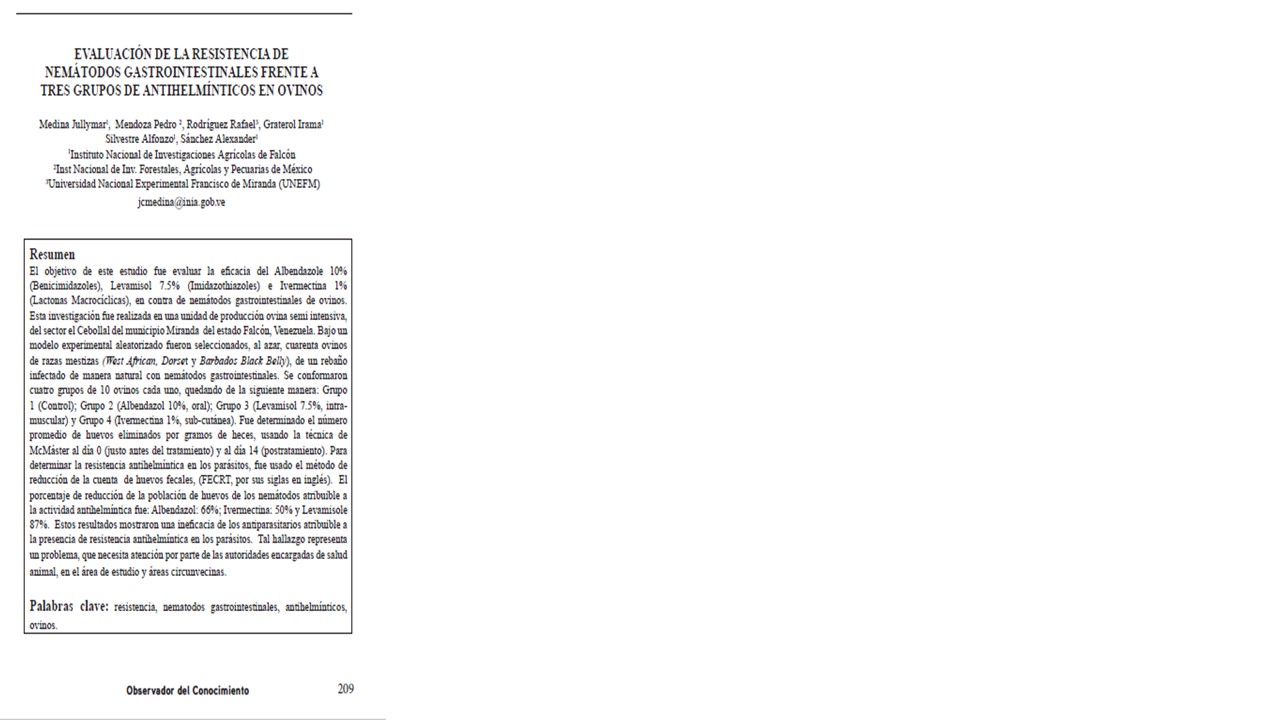Evaluation Of The Resistance Of Gastrointestinal Nematos Against Three Groups Of Antihelmínticos In Ovinos
Keywords:
Resistance, gastrointestinal nematodes, anthelmintics, sheepAbstract
The objective of this study was to evaluate the efficacy of Albendazole 10% (Benicimidazoles), Levamisol 7.5% (Imidazothiazoles) and Ivermectin 1% (Macrocyclic Lactones), against gastrointestinal nematodes of sheep. This research was carried out in a semi-intensive sheep production unit in the Cebollal sector of Miranda municipality in the state of Falcón, Venezuela. Under a randomized experimental model, forty sheep of mixed races (West African, Dorset and Barbados Black Belly) were randomly selected from a flock naturally infected with gastrointestinal nematodes.
Downloads
References
Benavides, O. (2001). Control de las pérdidas ocasionadas por los parásitos del ganado. Anexo coleccionable Manejo integrado de plagas y enfermedades en exploraciones ganaderas. Carta Fedegan. 69:52-63.
Coles, G.; Bauer, C.; Borgsteede, F. H. M.; Borgsteede, F.H.M.; Geerts, S.; Klei,
T. R.; Taylor, M.A.; Waller, P.J. (1992). World Association for the Advancement of Veterinary Parasitology (WAAVP) methods for the detection of anthelmintic resistance in nematodes of veterinary importance. Vet. Parasitol. 44: 35-44.
FAO. (2002). Food Agriculture Organization Network for helminthology in Africa. Global escalation of anthelmintic resistance (AR) calls for a re-evaluation of the problem. E. mail conference – summary, [en línea]. http:// www.fao.org
González, R.; Torres, G.; Nuncio, O. M.; Zermeño, J. (2007). Detección de eficiencia antihelmíntica en nematodos de ovinos de pelo con la prueba de reducción de huevos en heces. Livest. Res. Rural Develop. 15 (12): 22.
Leo, W.; Martin, P. CSIRO. (1990). Animal Health Research Laboratory, Parkville 3052.. ‘Reso’ FECRT analysis program (Version 2.0).
Márquez, D. (2003). Resistencia a los antihelminticos: Origen, desarrollo y control. Corpoica. 1: 55-71.
Montalvo, X.; López, A.; Vázquez, M.E.; Liébano, H.; Pedro, M. (2006). Resistencia antihelmíntica de nemátodos gastroentéricos en ovinos a Febendazol e Ivermectina en la Región Noroeste del Estado de Tlaxcala. Revista Técnica Pecuaria en México.44 (1): 1-90.
Morales, G.; Pino, L. (2001). Drogas antihelmínticassobre estróngilos digestivos en ovinos estabulados. Vet. Trop. 26(2): 147-158.
Nari, A.; Hansen, J.; Eddi, C.; Martins,J. (2000). Control de la resistencia a los antiparasitarios a la luz de los conocimientos actuales. XXI Congreso Mundial de Buiatría, Punta del Este, Uruguay.
Romero, J.; Boero, C.; Vásquez, R.; Aristizábal, MT.; Baldo, A. (1998). Estudio de la resistencia a antihelmínticos en majadas de la mesopotamia Argentina. Rev. Med. Vet. 70: 342-346.
Sievers, G.; Alocilla, A. (2007). Determinación de resistencia antihelmíntica frente a ivermectina de nemátodos del bovino en dos predios del sur de Chile. Arch. Med. Vet. 39: 67-69.
Van Wyk, J.A. (2001). Refugia – Overlooked as perhaps the most potent factor concerning the development of anthelmintic resistance. Onderstepoort. J. Vet. Res. 68:55-67.

Downloads
Published
How to Cite
Issue
Section
License

This work is licensed under a Creative Commons Attribution-NoDerivatives 4.0 International License.







